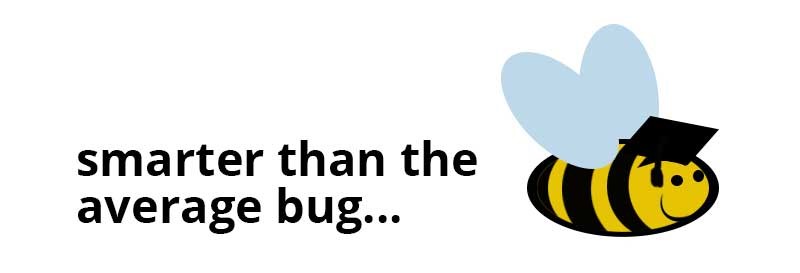Scientists have long studied insects and discovered some interesting information about their brains and intelligence. While they won’t be taking SATs anytime soon, here are a few “brainy” facts scientists have discovered about bug brains:
- Micro-Brains: A human brain has about 85 BILLION neurons. A bee has fewer than 1 million.
- Many Brains? Instead of having only one brain, insects have numerous sub-brains that can be controlled by a larger central brain. An insect can have a sub-brain for its eyes and another for each of its legs, its mouth, and antennae. Even if the sub-brain is destroyed, the sub-brain can keep the legs walking. Yeah, that’s just freaky.
- The Nerd Bugs: Honey bees, ants, and termites are considered the most intelligent insects.
- Long-legged Brains: An insect’s brain takes up a major portion of its body. Some tiny spiders have brains that fill their bodies and extend into their legs.
- Adapting Brains: Studies indicate intelligence in insects that adapt to a variety of food sources and habitats determining what is a good food source, home or a threat.
- Social Brains: Insects living and working in social groups require more intelligence than a tick that only needs to find a host and drink. They can recognize mates, communicate, know their place in insect society and fulfill it.
Bees have been the subject of major studies over the years, and scientist such as Lars Chittka have made some amazing discoveries into their world.
Lars say, “Every bee is entirely flower-naïve at the beginning of its foraging career.” Different flowers will require different methods to obtain the precious nectar. It’s not an instinct but a learning process. They learn by experiment but also by observing other bees. They observe, copy and remember what they’ve learned for next time. Bees possess the ability for facial recognition, can count (up to 4), work out a path that helps them get more for the distance they travel. They can scout for food, guard the hive, and fan their wings for ventilation.
One of the most interesting things is how they communicate with each other using symbols. It’s called a Waggle Dance. A bee returning to the hive after finding a food source will do the waggle dance on the inside of the hive indicating clearly where the source is. While shaking their bodies they will perform a dance in the shape of a coffee bean – an oval with a straight line down the center. The bee will start with the straight line. Straight means fly toward the sun; down means fly away from the sun, and left and right mean to fly to the left or right of the sun. As the bee dances in a figure eight pattern, the time it takes indicates how far away the find is. If done slowly, the distance is farther. If the source is a good one, the bee will repeat the dance over and over.
Lars study found that bees can determine symmetrical or asymmetrical shapes, pick objects based on concepts like “same” or “different.”
"They are fantastically smart," Chittka said. "Perhaps we are only amazed by this because we think small brains shouldn't be able to do it."
Studies now indicate it’s not the size of the brain but the relatively small number of cells working together to process complex concepts. Engineers are hoping to use this information to create smarter computers.
Sarah Farris, an evolutionary neurobiologist at West Virginia University in Morgantown said, “Knowing how an insect functions and produces complex behaviors with a brain that's a million-fold smaller than ours makes it a little easier to envision that we might be able to model some of these behaviors."


Recent Comments